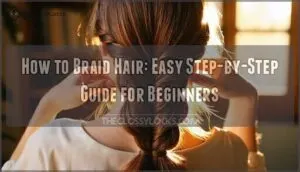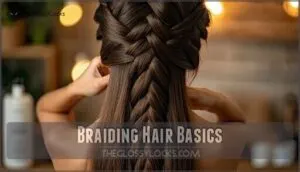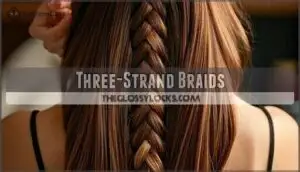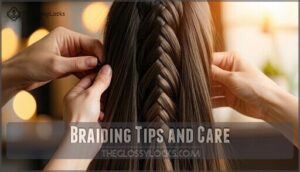This site is supported by our readers. We may earn a commission, at no cost to you, if you purchase through links.
 To braid hair, start by brushing it to remove tangles; smooth hair is your best friend here.
To braid hair, start by brushing it to remove tangles; smooth hair is your best friend here.
Split it into three equal sections—think of them as teamwork in motion. Cross the right section over the middle (it’s the new middle now), then cross the left section over the middle.
Keep alternating, pulling gently for a snug braid. If your hands feel like they’re square-dancing, don’t worry; it gets easier with practice.
Secure the end with a hair tie, and voilà, you’ve got a classic braid! Want to master fancy styles like fishtails or French braids? The fun’s just getting started.
Table Of Contents
- Key Takeaways
- Braiding Hair Basics
- How to Braid Hair
- Braiding Techniques
- Advanced Braiding Styles
- Braiding Tips and Care
- Frequently Asked Questions (FAQs)
- What is the easiest braid for beginners?
- Is it easier to braid wet or dry?
- What is a boxer braid?
- What is a cornrow braid?
- How do you do a reverse French braid?
- How to do a simple 3 strand braid?
- What’s the easiest braid to learn?
- How to do an easy braid on yourself?
- Can I braid wet hair without damaging it?
- How long do different braids last?
- Conclusion
Key Takeaways
- Detangle your hair first and divide it into three equal sections for neat and clean braiding.
- Cross the outer strands over or under the middle one alternately, keeping a steady tension throughout.
- Practice braiding on damp or slightly treated hair to minimize frizz and ensure a smoother braid.
- Secure your braid firmly with a hair tie, and explore styles like French, Dutch, or fishtail braids for variety.
Braiding Hair Basics
Braiding hair starts with clean, tangle-free strands and simple tools like a brush, elastics, and clips.
By learning to section hair evenly and maintain proper tension, you’ll create neat and secure braids every time.
Preparing Hair for Braiding
Before braiding, proper hair preparation is key. Focus on detangling, managing moisture balance, and controlling frizz. Tangle-free hair makes braiding smooth and stress-free.
Proper hair preparation ensures smooth, stress-free braiding—focus on detangling, moisture balance, and frizz control for flawless results every time.
- Brush ends to roots for effective detangling.
- Apply detangler spray for stubborn knots.
- Consider various spray options for ideal results.
- Use hair oil or smoothing cream for frizz control.
- Work with damp hair to maintain moisture balance.
- Section hair neatly for clean, precise braids.
Basic Braiding Technique
After untangling your hair, start by sectioning hair into three even sections.
For proper hand positioning, hold two sections in your left hand and one in your right.
Cross the right section over the middle, then the left. Focus on maintaining tension for neat, even braids.
Secure ends with a small tie. Practice makes easier braids!
How to Braid Hair
Learning how to braid hair opens up a world of creativity and practicality.
Braiding hair unlocks endless possibilities, blending creativity with practicality for styles that are both stunning and versatile.
To start, choose a clean, detangled section of hair, preferably slightly damp or treated with styling products to minimize frizz.
Follow these essential steps:
- Divide Hair into Sections: Split a section into three equal parts. Grip each securely but gently.
- Cross and Alternate: Move the right strand over the middle, then switch to the left. Repeat until you’ve reached the desired braid length.
- Secure the End: Use an elastic to tie it off, ensuring the braid stays intact.
Braiding reflects diverse origins and cultural symbolism while offering variations like simple three-strand or intricate styled braids.
With practice, braided hairstyles add personal flair to your everyday look.
Braiding Techniques
Braiding techniques help you transform simple sections of hair into intricate designs with just a few steps.
Whether you’re creating a classic three-strand braid or experimenting with more advanced styles like a fishtail or five-strand braid, mastering the basics is key.
Three-Strand Braids
Mastering a three-strand braid reveals endless braided hairstyles. Start with clean, tangle-free hair and precise sectioning techniques. Divide the hair into three equal sections and alternate crossing outer strands over the center, maintaining braid tightness.
Experiment with styling variations, braid placement, and hair types for unique looks. For specialized tools, explore options for braiding hair products.
Practice makes perfect—easy braids can become second nature.
| Step | Action | Tip |
|---|---|---|
| 1 | Brush hair thoroughly | Detangle from root to tip |
| 2 | Divide into three sections | Keep sections equal in size |
| 3 | Cross right over center | Maintain tension consistently |
| 4 | Cross left over center | Smooth hair as you braid |
| 5 | Secure with an elastic | Choose a fabric-wrapped elastic |
French Braids
French braids take the classic three-strand braid up a notch, offering endless styling options.
Start by parting your hair evenly, grabbing a top section, and dividing it into three strands.
Cross each side over the middle while adding volume by integrating hair from the sides, which helps in keeping everything sleek and secure—this is perfect for maintaining shape throughout your day.
Dutch Braids
The Dutch braid, often called the inverted French braid, uses an underhand technique for a raised effect.
Start with three sections near your crown, crossing strands under the middle instead of over.
Add small hair sections as you braid. Keep tension steady for a cleaner look.
This beginner-friendly braid tutorial is perfect for mastering unique hair braiding techniques and styling variations.
Fishtail Braids
To create a fishtail braid, divide your hair into two even sections.
Take a small piece from one section, cross it over, and add it to the other section. Alternate this technique, working down to the ends.
Fishtail variations offer intricate styling options, perfect for casual or elegant looks. With practice, beginner fishtails become effortless.
Five-Strand Braids
To tackle the intricate five-strand braid, start with clean, tangle-free hair. Sectioning is key to stability—divide it into five equal strands.
- Cross the outer-right strand over and under neighbors.
- Repeat with the outer-left strand.
- Use consistent weaving techniques for neatness.
- Prevent slippage with light styling gel.
- Secure with a ribbon for flyaway control.
Advanced Braiding Styles
Once you’ve mastered basic braids, it’s time to explore more intricate styles that elevate your skillset.
Advanced braiding techniques, like waterfall or crown braids, let you create stunning designs perfect for special occasions or everyday flair.
Waterfall Braids
Waterfall braids add elegance with cascading strands, perfect for any occasion.
Start by sectioning hair at one temple. Braid as you’d a French braid, but let one strand fall loose to create the "waterfall." Repeat along the head. Secure firmly.
Here’s a quick guide:
| Braid Variation | Hair Type | Occasion Suitability | Maintenance Tips |
|---|---|---|---|
| Waterfall braid | Straight or wavy | Formal or casual | Use light styling gel |
| French-inspired | Fine or thick | Weddings, dinners | Comb lightly, avoid frizz |
| Unique styling | Textured hair | Any stylish event | Pin stray strands securely |
| Tutorial-ready | Smooth/damp hair | Hair tutorial practice | Regular brushing prevents kinks |
The Waterfall braid is suitable for various hair types and occasions, including formal events and casual gatherings, making it a versatile hairstyle option.
Ladder Braids
Ladder braids add a woven, intricate look to your hairstyle that’s surprisingly simple with practice.
Start by creating a standard braid on one side, leaving small strands loose at intervals.
Use these loose strands to weave a second braid parallel to the first.
For extra flair, explore Ladder Braid Variations with extensions, updos, or accessories, bringing unique texture to your style.
Heart Pull-Through Braids
The heart pull-through braid, perfect for romantic events, combines a chic look with moderate difficulty.
Unlike traditional braiding techniques, this style uses elastics to shape a heart along the braid’s length, creating a standout design.
Popular in hair tutorials for unique hair braiding styles, it’s occasion-appropriate for weddings or date nights, offering braid longevity with proper styling variations.
Crochet Braids
Crochet braids are an easy way to blend synthetic hair with your natural look.
Start by braiding hair into cornrows as your base. Use a latch hook to attach pre-looped hair extensions securely.
Choose from vibrant colors, textures, and lengths for endless styles.
For crochet maintenance, moisturize your scalp, detangle gently, and sleep with a satin scarf for durability.
Crown Braids
Crown braids, often called halo braids, give you a royal look with minimal effort.
Start by parting your hair evenly, then use Dutch braid techniques, weaving under instead of over.
Wrap the braid around your head for the "halo effect".
This styling option works for casual days or special occasions, offering braid variations and elegance. Finish with pins and maintenance tips!
Braiding Tips and Care
Mastering braiding techniques is easier when you know how to work with different hair types and care for your finished styles.
With a few straightforward tips, you can prevent common issues like frizz, tension, or uneven sections while keeping your braids looking fresh and neat.
You can keep your braids looking fresh by following these tips.
Braiding Fine Hair
When braiding fine hair, start with clean, tangle-free strands.
Use a light mousse or texturizing spray for grip enhancement and adding volume.
Choose braid styles like a three-strand or Dutch braid for a fuller effect.
Avoid over-tightening to prevent damage, and secure ends with soft elastics.
Consider a volumizing powder at the roots for a polished look.
Braiding Thick Hair
Tackling thick hair for braiding? Start with sectioning techniques to manage volume. Keep tension control steady for a neat finish.
Here are tips:
- Use wide-tooth combs for clean sections.
- Braid damp hair to reduce frizz.
- Apply texturizing hair products for hold.
- Try Dutch braid styles for fullness.
- Secure ends with elastics for lasting results.
Braiding Curly Hair
Curly hair adds flair to braids, but it needs extra care.
Start with moisturized hair for curl definition and frizz control. Detangle gently, then choose braid styles that suit your hair type.
Add hydration-friendly products for moisture retention and sleek results.
Remember these braiding hair tips: secure with soft ties, practice patience, and embrace your natural texture, which helps with moisture retention and achieving sleek results.
Caring for Your Braids
Taking care of braids keeps them fresh and your hair healthy. Focus on braid hydration, scalp care, and night protection.
- Use braid products like oils or serums to moisturize the scalp evenly.
- Wash braids gently every 1-2 weeks to prevent product buildup.
Wrap hair in silk before bed to maintain style longevity. Proper care often involves using a quality moisturizing serum.
Common Braiding Mistakes to Avoid
Even seasoned braiders stumble on tension control, sectioning errors, or product overuse.
Tight braids strain roots, uneven sections create chaos, and too much product causes braid slippage.
Secure ends snugly but avoid over-pulling.
Check out this quick guide:
| Mistake | Impact | Fix |
|---|---|---|
| Tight Braids | Hair damage | Maintain light tension at roots |
| Uneven Sections | Messy braids | Use a rat-tail comb for clean sectioning |
| Loose Ends | Braids unravel | Tie ends firmly with a hair elastic |
To achieve better braiding results, remember that secure ends and even sections are crucial, and always be mindful of product overuse to prevent hair damage.
Frequently Asked Questions (FAQs)
What is the easiest braid for beginners?
The three-strand braid is perfect for beginners.
Divide hair into three sections, cross the right over the middle, then the left.
Repeat while keeping tension consistent.
It’s straightforward, neat, and a great starting point!
Is it easier to braid wet or dry?
Braiding wet hair is like sculpting with soft clay—it’s smoother and holds tighter.
Damp hair strikes a perfect balance, especially for beginners.
Dry hair gives you more texture but can slip or frizz.
What is a boxer braid?
A boxer braid is a sleek hairstyle, combining two Dutch braids tightly woven from the hairline to the nape.
It’s perfect for intense activities, offering both style and practicality by keeping hair secure and neat.
What is a cornrow braid?
Did you know cornrows date back over 3,000 years to ancient Africa?
These tight, scalp-hugging braids create intricate patterns by weaving small sections under each other.
They’re durable, stylish, and perfect for protective styling.
How do you do a reverse French braid?
To do a reverse French braid, start with three hair sections at the crown.
Cross strands underneath the middle instead of over.
Keep adding small pieces from each side as you work downward, securing tightly, using the reverse method to achieve the desired braid.
How to do a simple 3 strand braid?
Did you know 68% of people find braiding hard until they practice?
Start with three sections, cross the right over the middle, then the left.
Repeat, keeping tension steady, and secure with an elastic.
What’s the easiest braid to learn?
The easiest braid to learn is the three-strand braid.
Start by dividing your hair into three equal sections, cross the right over the middle, then the left.
Repeat this pattern until it’s fully braided!
How to do an easy braid on yourself?
Think of braiding as weaving a story with your hands.
Divide your hair into three sections, cross the outer strands over the middle, alternating sides.
Keep the tension even, and secure with an elastic.
Can I braid wet hair without damaging it?
You can braid wet hair if you’re careful.
Use a wide-tooth comb to detangle first, then apply a leave-in conditioner.
Braiding while damp helps control frizz, but don’t pull too tightly to avoid breakage.
How long do different braids last?
Beautiful braids boast varying lifespans—classic three-strand braids last 1-2 days.
Dutch or French styles hold for 2-4 days, while tighter ones like box braids endure weeks.
All depending on technique, hair type, and maintenance.
Conclusion
Did you know that braiding dates back at least 5,000 years, symbolizing culture and community?
Now that you’ve mastered how to braid hair, you’re equipped to explore endless styles, from three-strand classics to intricate fishtails and crowns.
Remember, practice sharpens your technique—precision and patience go hand in hand.
Whether you’re styling for fun, tradition, or function, keep your sections even and tension consistent.
With creativity and care, braiding can become your go-to hairstyle for any occasion.











